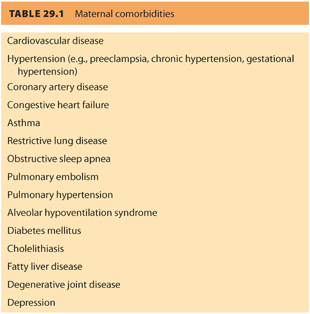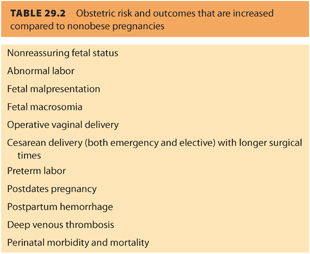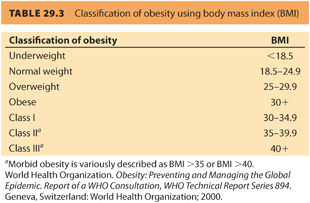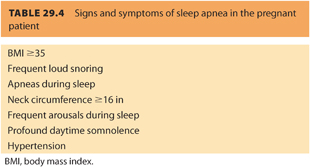B. Maternal comorbidities. Obesity is implicated as a direct cause in the development of disease in many organ systems (see Table 29.1). As maternal body mass index (BMI) increases, the probability of concomitant diseases also increases.1 Besides an increased likelihood of chronic hypertension and type 2 diabetes mellitus (DM), obese parturients are more likely to have preeclampsia, fetal macrosomia, and a twofold increase in cesarean delivery (CD).2–5 There has been increasing interest in the relationship between “near-miss morbidity and mortality” and comorbid conditions. Although obesity was not independently associated with near-miss morbidity and mortality, a recent study using the 2003 to 2006 Nationwide Inpatient Sample found that hypertensive disorders of pregnancy, previous CD, DM, preexisting hypertension, and multiple gestations were the most common comorbidities associated with near-miss morbidity and mortality.6

C. Obstetric risk and outcomes. There is an increased incidence of various obstetric complications associated with obesity. They are listed in Table 29.2. Besides an increased risk of CD,7,8 there are more labor inductions for postdates pregnancy and there is an increased incidence of failed induction in the obese parturient.8 The first and second stages of labor are prolonged, and oxytocin augmentation is also more frequent. Excess adipose tissue may make fetal heart rate (FHR) and uterine contractions difficult to monitor, so fetal scalp electrodes and internal pressure monitors are often necessary during labor. There is a positive correlation between the use of oxytocin for labor augmentation and increasing BMI.3,9 Dysfunctional labor is more common in obese women compared to nonobese women,4 although it is not more painful in obese women.10 Prolongation of the second stage of labor is more common and correlates with increasing BMI. The success of trial of labor after CD is also less likely.11 Fetal macrosomia has been implicated in higher CD rates in obese women. There is an increase in frequency of meconium-stained amniotic fluid and intrapartum FHR abnormalities requiring CD,8 plus a higher incidence of instrumental deliveries and third-degree or fourth-degree perineal lacerations.8 Several studies have found an increased risk of postpartum hemorrhage among obese parturients.4,12 Sebire et al.4 also found a linear relationship of postpartum hemorrhage with increasing BMI. Keep in mind that hemorrhage remains a leading cause of maternal mortality.13

CLINICAL PEARLAs maternal BMI increases, the probability of concomitant diseases also increases. Hypertensive disorders of pregnancy, previous CD, DM, preexisting hypertension, and multiple gestations are common comorbidities and can be associated with near-miss morbidity and mortality.
II.Obesity: definition and demographics
A. Consensus for definition of obesity. In the past, there was no consensus for the definition of obesity or morbid obesity. Some used absolute weights (e.g., 100 kg and above), whereas others used a percentage above ideal body weight or skin caliper fat thickness measurements to define obesity. Insurance companies, most notably the Metropolitan Life Insurance Company, developed their own height/weight tables based on actuarial data. As a result of these inconsistencies, it is difficult to compare older studies with more recent studies that use the BMI.
B. Body mass index. BMI is a function of patient’s weight in kilograms divided by height in meters squared (kg per m2). The World Health Organization (WHO) and the National Institutes of Health (NIH) have both adopted the BMI to classify degree of obesity. Although BMI can misclassify a very small subset of the population, it has standardized the classification of weight ranges from underweight to morbid obesity (see Table 29.3). The Institute of Medicine14 has published a range for weight gain during pregnancy that limits the gain to 11 to 25 lb when the BMI is greater than 30 kg per m2 and 15 to 25 lb when the BMI is between 25 and 29.9 kg per m2. The American College of Obstetricians and Gynecologists recommends that height and weight be recorded at the first prenatal visit and weight gain monitored periodically.5

C. Increasing incidence of obesity. The prevalence of obesity correlates with socioeconomic status. In developed countries, poverty is associated with obesity; in developing countries, affluence is associated with obesity.1 According to the WHO criteria, the incidence of obese women in the United States has reached epidemic proportions—more than doubling in a 10-year period from 1994 to 2004. Recent estimates suggest that more than one-third of all US women are obese, more than 50% of pregnant women are overweight or obese, and nearly 10% of women of reproductive age are extremely obese.15 Similar rates of increase can be found in the United Kingdom and other countries.
CLINICAL PEARLRecent estimates suggest that more than one-third of all US women are obese, more than 50% of pregnant women are overweight or obese, and nearly 10% of women of reproductive age are extremely obese.
III.Physiologic changes of obesity and pregnancy
A. Pulmonary
1. The pulmonary system adapts to meet the increased oxygen and ventilation demands of pregnancy. Typically, minute ventilation increases by 50% at term and PaCO2 is decreased to approximately 34 mm Hg. Although functional residual capacity (FRC), expiratory reserve volume (ERV), and residual volume (RV) are all decreased due to the cephalad displacement of the diaphragm by the gravid uterus, total lung capacity is not changed because of an increase in chest circumference. The smooth muscle relaxation effect of progesterone in pregnancy may decrease airway resistance and improve respiratory function.16 In the obese parturient, oxygen consumption is increased in direct proportion to the additional adipose tissue. The physiologic demands and added weight of the excess adipose tissue frequently result in respiratory compromise. Mechanically, the posture of the obese parturient involves an accentuated thoracolumbar lordosis (kyphosis) and a modified thoracic curvature. Rib cage and sternal mechanics are diminished resulting in increased work of breathing and possibly a deterioration of ventilatory parameters. During quiet respiration, the diaphragm is the principal muscle of inspiration and expiration. Forced expiration is dependent on abdominal wall muscles and intercostal muscles.
2. In obese parturients, chest wall adipose tissue exerts pressure on the thorax and intraabdominal adipose tissue enhances the cephalad shift of the diaphragm. This results in a further reduction in FRC, greater atelectasis formation, and an increase in closing volume that often exceeds FRC. Supine, lithotomy, and/or Trendelenburg position exacerbate this respiratory impairment. A greater closing volume (the lung volume during expiration at which airways begins to close) produces abnormal distribution of ventilation. This, in turn, results in a ventilation–perfusion mismatch (intrapulmonary shunt) and impaired arterial oxygenation. In order to elucidate the effects of airway closure, room air oxygen saturation can be measured in the sitting and supine position to identify those individuals who may require additional respiratory assistance (e.g., supplemental oxygen, chest physiotherapy) during labor or CD.
CLINICAL PEARLTo determine if a patient is experiencing the effects of airway closure and impaired arterial oxygenation, room air oxygen saturation should be measured in the sitting and supine position to identify those individuals who may require additional respiratory assistance (e.g., supplemental oxygen, chest physiotherapy) during labor or CD.
3. Spinal anesthesia in parturients is associated with a BMI-dependent decrease in lung function. The baseline spirometric measurements in nonobese and obese parturients at term are similar. Spinal anesthesia causes minimal changes in spirometric volumes in normal-weight, nonpregnant patients. In the term parturient, however, spinal anesthesia to T5 level results in significant decrease in vital capacity, forced vital capacity, forced expiratory volumes in 1 second, and peak expiratory flow rate (PEFR) and midexpiratory flow rates. In the obese parturient receiving spinal anesthesia, a decrease in vital capacity is significantly greater when compared to parturients with normal BMI and correlates well with increasing BMI. This effect is seen for more than 3 hours after initiation of spinal anesthesia for CD.17
4. Obstructive sleep apnea (OSA) is characterized by intermittent pharyngeal obstruction resulting in episodic apnea during sleep. Diagnosis can be made using the STOP-BANG tool18 and for those at risk, the definitive test is a sleep study. Because most parturients are undiagnosed during pregnancy, these patients can present the greatest challenges to anesthesia providers.19 Patients at risk should be screened and treated if diagnosed. Signs and symptoms of sleep apnea in the pregnant patient are listed in Table 29.4.

The main causes of obstruction are oropharyngeal soft tissue enlargement (as a result of increased fat) and pregnancy-related changes. Hormone-induced increases in respiratory center sensitivity during early pregnancy may decrease OSA symptoms.9,16 Later in pregnancy, women tend to sleep in the lateral position and therefore the likelihood of airway obstruction is mitigated. Recent data from the Nationwide Inpatient Sample suggest that the rate of OSA has increased from 0.3 per 10,000 to 7.3 per 10,000 from 1998 to 2009.20 In the cohort, sleep apnea increased the odds for the following outcomes: (1) cardiomyopathy (odds ratio [OR], 9.0; 95% confidence interval [CI], 7.5 to 10.9), (2) eclampsia (OR, 5.4; 95% CI, 3.3 to 8.9), (3) pulmonary embolus (OR, 4.5; 95% CI, 2.3 to 8.9), and (4) preeclampsia (OR, 2.5; 95% CI, 2.2 to 2.9). In addition, there was a fivefold increased odds of in-hospital mortality. These patients will require postpartum monitoring of respiratory function while in hospital, especially if they receive any opioid analgesics. They should sleep in a 45-to 60-degree head-up position and may require supplemental oxygen therapy. A consult with the respiratory service is recommended in order to offer continuous positive airway pressure (CPAP) therapy and follow their progress throughout the hospital stay.
CLINICAL PEARLPatients with OSA will require postpartum monitoring of respiratory function while in hospital, especially if they receive any opioid analgesics. CPAP therapy should be considered to minimize airway collapse and desaturation postoperatively.
5. Obesity hypoventilation syndrome (OHS), also known as Pickwickian syndrome, is a combination of severe obesity and OSA. Witnessed snoring, episodes of apnea, irregular breathing patterns during sleep, restless sleep, and daytime fatigue are often presenting symptoms. Identifying the patient with OSA who has OHS is difficult in the nonpregnant patient, but the physiologic changes of pregnancy will alter such measures as low oxygen saturation, hypercapnia (while breathing room air), and elevated serum bicarbonate that have been suggested as screening tools.21 Chronic hypoxemia and hypercapnia may lead to polycythemia, pulmonary hypertension, and right ventricular dilation and failure (cor pulmonale).22 Pickwickian syndrome in pregnancy may be mitigated by increased progesterone during pregnancy.16
6. The prevalence of asthma is increased in the obese population. Weight loss may improve and/or eliminate asthma symptoms. Because there is a strong correlation between gastroesophageal reflux disease (GERD) and BMI in women,23 some have speculated that acid reflux may be the cause of asthma in obese women.
7. Obesity and pregnancy can both cause restrictive lung disease by virtue of reducing chest wall compliance. In restrictive lung disease, pulmonary function tests reveal hypoxemia, decreased ERV, decreased maximum voluntary ventilation, and decreased FRC.9 To maximize efficiency of breathing, the obese parturient will alter her breathing pattern by decreasing tidal volume and increasing respiratory rate. The effects of progesterone may alleviate some of the restrictive symptoms.16 Unfortunately, the symptoms are exacerbated in the supine position necessary for surgery. Because the parturient is usually awake for CD, she needs to be managed in a ramped position and reassured that her respiratory function is adequate. Supplemental oxygen is usually necessary. If the patient receives general anesthesia, greater positive pressure with larger tidal volumes may be required to ventilate the obese parturient to mitigate the reduction of FRC as it falls below closing capacity (CC). However, the ventilation parameters must be balanced for optimal gas exchange and prevention of barotrauma.
B. Cardiovascular
1. Hypertension is common in the obese population and is positively correlated with BMI.22 Even when patients with chronic hypertension are excluded, hypertension is more common in the obese population.11 In a study of more than 56 million deliveries between 1995 and 2008, the prevalence of primary and secondary hypertension increased from 0.9% in 1995–1996 to 1.52% in 2007–2008. 24 The following adverse maternal outcomes were noted in 731,694 patients with chronic hypertension: (1) acute renal failure (21%), (2) pulmonary edema (14%), (3) preeclampsia (11%), and (4) in-hospital mortality (10%). Because obesity is an independent risk factor for developing preeclampsia,3,4,25 the incidence of preeclampsia doubles with each 5 to 7 kg per m2 increase in prepregnancy BMI.25 Both hypertension and preeclampsia in obese parturients independently increase risk of CD. Hypertensive disease remains a leading cause of maternal mortality.13
2. Blood pressure (BP) monitoring may be particularly problematic in obese patients. The BP cuff must be of appropriate size to obtain an accurate BP. If the BP cuff is too small, the BP reading will be overestimated. The forearm of the patient can be used if the upper arm is too large or of a noncylindrical shape. An arterial line may be needed to accurately determine BP. It also permits arterial blood gas sampling in patients with suspected respiratory dysfunction.
3. In obese, term parturients without hypertension, left ventricular wall thickness can be significantly greater when compared to term parturients with normal BMI. Left ventricular size and function, however, can be normal. The change in left ventricular geometry decreases the radius-to-wall thickness ratio and may be an adaptation to preserve normal systolic function despite increased cardiac output. Furthermore, the heart rate must increase to elevate cardiac output, thereby decreasing the diastolic interval and time for myocardial perfusion. Impaired myocardial diastolic relaxation leads to diastolic dysfunction. The combination of diastolic dysfunction and rapid heart rate may lead to pulmonary edema.
4. Morbid obesity is associated with poor cardiac function during pregnancy.9,22 Obesity is an independent risk factor for the development of heart failure and the risk increases with increasing BMI.26 Although obesity is associated with hypertension, coronary artery disease, left ventricular hypertrophy, and DM, all of which are important causes of heart failure, multivariate analysis concludes that BMI is a significant independent predictor of heart failure. Whether obesity itself or some intermediary mechanism (e.g., fat deposition in the myocardium or conduction pathways) is responsible for the heart failure is unknown.
5. Obesity cardiomyopathy is a clinical syndrome generally found in patients with BMI ≥40 for 10 years or greater.27 In normal-weight parturients, circulating blood volume increases by approximately 45% above prepregnancy levels as a result of an increase in plasma volume and red blood cell mass. To meet the metabolic demands of the increased tissue mass in obese patients (every 100 g of fat increases cardiac output by 30 to 50 mL per minute), the blood volume, stroke volume, and cardiac output in obese parturients are greater than that of a patient with normal BMI. Interestingly, the magnitude of blood volume increase in obese parturients is less than that predicted by their weight. However, the increase in blood volume may lead to left ventricular dilation, increased left ventricular wall stress, compensatory left ventricular hypertrophy, and diastolic dysfunction. Over time, the heart may dilate and fail.9 Echocardiography is a useful test of cardiac function in these patients.
6. A conglomerate of diseases known as metabolic syndrome, a major risk factor for the developing cardiovascular disease, is characterized by insulin resistance, dyslipidemia, elevated C-reactive protein, increased propensity for thrombosis, and activation of the sympathetic nervous system. Metabolic syndrome plus hypertension may render the obese patient at high risk for development of coronary artery disease. A routine electrocardiogram is prudent, and one should have a high index of suspicion for ischemic heart disease.
7. Supine hypotension syndrome (SHS) is a well-known phenomenon in parturients after mid second trimester. The weight of the obese abdominal wall further enhances uterine compression on the abdominal vasculature. Cardiovascular collapse and death have been reported in obese patients in the supine position.28 Left uterine displacement is therefore essential to prevent SHS.
CLINICAL PEARLCardiovascular disease is associated with adverse outcomes in morbidly obese parturients including acute renal failure, pulmonary edema, preeclampsia, and in-hospital mortality.
C. Endocrine
1. Type 2 DM is the paradigm of obesity-related disease. It is often caused by obesity and will often resolve with weight loss. Using a baseline BMI of 21, the Nurses’ Cohort Study found that the risk of developing type 2 DM was increased fivefold for BMI of 25, 35-fold for BMI of 30, and 93-fold for BMI >35.2 Other groups have found similar trends of increasing incidence and insulin use with increasing BMI.3
2. In pregnancy, the placenta secretes contrainsulin hormones (e.g., human placental lactogen [hPL], human chronic gonadotropin [hCG], steroids), and insulin resistance becomes an increasing problem as pregnancy progresses. The likelihood of developing gestational diabetes mellitus (GDM) correlates well with prepregnancy BMI. Weiss et al.7 found that 2.3% of normal-weight parturients developed GDM, whereas 6.3% of obese and 9.5% of morbidly obese patients developed GDM. The combination of preexisting insulin resistance of obesity and the insulin resistance of pregnancy likely leads to the large amounts of insulin required to achieve glycemic control. The large insulin requirement, in turn, may lead to excessive gestational weight gain. Therefore, a vicious cycle of increasing insulin and weight gain ensues.
3. DM has significant adverse effects on the fetus (see Chapter 23). Perinatal mortality in both type 1 and type 2 DM is increased fourfold. The incidence of congenital anomalies in offspring of mothers with DM is twice that seen in nondiabetic pregnancies. There is a fourfold increase in neural tube defects and threefold increase in congenital heart disease. It is well accepted that maternal obesity is a risk factor for fetal macrosomia but the cause is unclear. Some believe that maternal DM and hyperinsulinemia leads to fetal macrosomia, whereas others have found that maternal obesity without DM may cause fetal macrosomia.29 Good glycemic control reduces the risk of adverse perinatal outcomes. HbA1c levels should be <7%.
D.Hypercoagulability
1. Venous thromboembolism (VTE) is a leading cause of maternal mortality. The risk of VTE is five times higher in a pregnant woman than in a nonpregnant woman of similar age.30 The incidence of VTE in obese parturients is more than twice that of nonobese controls. Obesity is an independent risk factor for deep vein thrombosis (DVT).9 In women younger than 40 years, the relative risk for DVT is increased sixfold in obese versus nonobese patients. Several reasons may account for the increased incidence of venous thrombus formation:
a. Immobility
b. Increased lower extremity venous stasis—secondary to increased inferior vena cava pressure as a result of increased intraabdominal pressure
c. Vascular damage occurs with both vaginal deliveries and CD.
d. Pregnancy-induced hypercoagulable state—increase in fibrin and factors II, VII, and X and decrease in protein S and fibrinolytic system
e. Decreased fibrinolytic activity (decreased in individuals with a combination of hyperlipidemia and insulin resistance) and increased fibrinogen levels in obesity are also contributory. Fibrinogen levels increase in proportion to increasing BMI.
f. Increased thromboxane production, secondary to hyperlipidemia
g. Polycythemia leading to increased blood viscosity
2. Increased recognition and screening tools (i.e., Doppler ultrasound) and increased use of thromboprophylaxis have decreased the incidence of lower extremity venous thrombi. Both unfractionated and low molecular weight heparin (LMWH) are mainstays of thromboprophylaxis. An anticoagulated patient provides a challenge for the anesthesiologist. The major concern involves the increased risk of epidural hematoma following placement of a neuraxial blockade. Variations in the type of anticoagulant and dosing regimen have led to different recommendations regarding the appropriate timing for safely administering neuraxial blockade.31
CLINICAL PEARLVTE is a leading cause of maternal mortality. Obesity is an independent risk factor for DVT.
E. Gastrointestinal
1. The combination of obesity and pregnancy greatly increases the risk for gastric content regurgitation and possibly pulmonary aspiration. The frequency of GERD is strongly correlated with increasing BMI in women.23 Physiologic changes in normal pregnancy include a decrease in lower esophageal sphincter tone. In laboring women, gastric motility decreases and emptying may cease completely. Parenteral and neuraxial opioid administration contribute to decreased gastric motility. Obese patients may have larger gastric volumes and lower gastric pH.32 Obese parturients are less mobile, which also increases the risk of aspiration. The increased risk of pulmonary aspiration necessitates strict nothing by mouth guidelines and the timely administration of nonparticulate antacids, H2-receptor antagonists, and/or metoclopramide before induction of anesthesia.33 Because obese parturients have lower gastroesophageal junction tone and an increased risk of airway difficulty, their risk for aspiration is increased.
2. Fatty liver is commonly observed in obese individuals with an estimated incidence of 60% to 90% among morbidly obese patients.34 It is the most common cause for elevated transaminases in the United States. The risk of steatosis increases with type 2 DM, hyperlipidemia, and/or hypertension. Unlike the clinically significant microvesicular steatosis found in fatty liver of pregnancy, the macrovesicular fatty liver associated with obesity is usually a benign process. In rare cases, fatty liver associated with obesity may progress to fibrosis, cirrhosis, and liver failure. If liver function is compromised, evaluation for possible coagulopathy must be considered. Decreased liver function also results in altered drug metabolism and clearance.
IV.Anesthesia for the obese pregnant woman
A. Obesity and maternal mortality. In the 2006 to 2008 Confidential Enquiries into Maternal Deaths and Child Health in the United Kingdom, 49% (n = 227) of the women who died from either direct (e.g., thromboembolic disease, preeclampsia, hemorrhage) or indirect (e.g., cardiac disease) causes and for whom the BMI was known were either overweight or obese.13
B. Patient evaluation. Both the physician and the obese parturient benefit from antenatal anesthetic evaluation. The American College of Obstetricians and Gynecologists (ACOG) recommends anesthesiology consultation for obese women antepartum or “early in labor” to allow adequate time for development of an anesthetic plan.5 Unfortunately, the availability of antenatal anesthesia clinics is scarce—approximately 30% in a UK survey.35 Manpower and financial constraints are factors that limit availability of antenatal clinics. However, even without a defined clinic, a sensitive discussion with the patient and her support group as soon as she arrives on the labor and delivery unit should include a dialogue about the potential difficulty of initiating labor analgesia and risk of failure as well as the goals for patient safety. Although surveys suggest that these discussions are rare because of concerns of offending the patient,36,37 failure to address these concerns can contribute to unrealistic patient expectations or incomplete informed consent. Because obesity is a social disability and is stigmatized by society, all members of the health care team should be sensitive in their interactions with obese parturients.
C. General considerations. Besides the technical challenges in airway management and placement of neuraxial blocks, there are associated medical problems and technical considerations. Obese women should be screened for glucose intolerance early in pregnancy. BP should be properly measured with correct cuff size. If this is not possible, then an arterial line should be placed. Accurate assessment of gestational age should be determined by serial ultrasonographic examinations. Patients should be made aware of the increased difficulty in establishing analgesia and anesthesia, and early neuraxial analgesia should be encouraged. Venous access may be difficult to obtain and extravasation of an intravenous (IV) cannula can be easily overlooked. Ultrasound-guided IV cannulation may facilitate venous access. Obese parturients have a greater potential for blood loss during CD and the postpartum period, so well-functioning, large-bore IV access is essential. Patients need to be informed of the potential need for central venous access, both for hemodynamic monitoring and reliable IV access. Blood products also need to be readily available because of the increased risk of uterine atony and postpartum hemorrhage.
CLINICAL PEARLPreparation should include BP monitoring and placement of adequate IV access early in labor. Blood products also need to be readily available.

Full access? Get Clinical Tree








